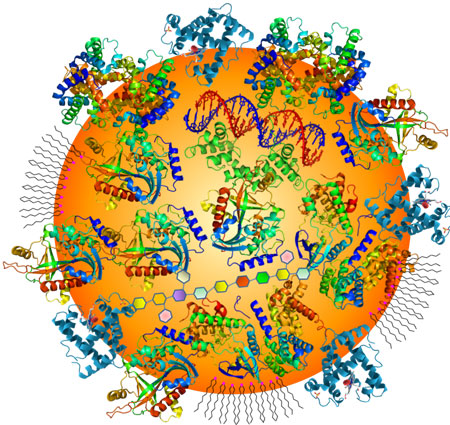Cancer is one of the leading causes of death in the world and remains a difficult disease to treat. Current problems associated with conventional cancer chemotherapies include insolubility of drugs in aqueous medium; delivery of sub-therapeutic doses to target cells; lack of bioavailability; and most importantly, non-specific toxicity to normal tissues. Recent contributions of nanotechnology research address possible solutions to these conundrums. Nevertheless, challenges remain with respect to delivery to specific sites, real time tracking of the delivery system, and control over the release system after the drug has been transported to the target site.
Nanotechnology applications to diagnose and treat cancers are already a reality providing a wide range of new tools and possibilities, from earlier diagnostics and improved imaging to better, more efficient, and more targeted therapies.
Cancer Diagnostics
More lives could be saved by early detection of cancer than by any form of treatment at advanced stages. Circulating tumor cells (CTCs), which are viable cells derived from tumors, are hypothesized to represent the origin of metastatic disease.
Nanotechnology can be used to develop devices that indicate when those markers appear in the body and that deliver agents to reverse premalignant changes or to kill those cells that have the potential to become malignant.
For instance, a quick and simple blood test to detect early-stage cancer relies on the discovery of cancer biomarker molecules from the 'protein corona' formed on the gold nanoparticles upon adsorption of blood serum proteins to the nanoparticle surface.

Illustration of a protein corona formed on a gold nanoparticle (AuNP) surface upon adsorption of blood serum proteins and other biomolecules. (Image: Dr. Huo, University of Central Florida)
With increasing accuracy, liquid biopsies – where CTCs are isolated from blood samples – are becoming a viable complement or even alternative to invasive biopsies of metastatic tumors. CTCs are of great interest for evaluating cancer dissemination, predicting patient prognosis, and also for the evaluation of therapeutic treatments, representing a reliable potential alternative to invasive biopsies and subsequent proteomic and functional genetic analysis.
Quantum dots in particular have finally taken the step from pure demonstration experiments to real applications in imaging. In recent years, scientists have discovered that these nanocrystals can enable researchers to study cell processes at the level of a single molecule. This may significantly improve nanotechnology cancer diagnostics and treatment. Fluorescent semiconductor quantum dots are proving to be extremely beneficial for medical applications, such as high-resolution cellular imaging.
Cancer Therapy
In therapy, nanotechnology to kill cancer cells is at the forefront of both targeted drug delivery and intrinsic therapies. For instance, nanoparticles can be used as tumor-destroying hyperthermia agents that are injected into the tumor and then be activated to produce heat and destroy cancer cells locally either by magnetic fields, X-Rays or light.
Sneaking existing chemotherapy drugs or genes into tumor cells via nanomaterials allows much more localized delivery both reducing significantly the quantity of drugs absorbed by the patient for equal impact and the side effects on healthy tissues in the body.
Coupling both modes of action has also been achieved with gold nanorods carrying chemotherapy drugs and locally excited in the tumor by infrared light. The induced heat both releases the encapsulated drug and helps destroying the cancer cells, resulting in a combined effect of enhanced delivery and intrinsic therapy.
Smart cancer theranostics a combination of the words therapeutics and diagnostics describes a treatment platform that combines a diagnostic test with targeted therapy based on the test results, i.e. a step towards personalized medicine.
Cancer Theranostics
Theranostics – a combination of the words therapeutics and diagnostics – describes a treatment platform that combines a nanotechnology cancer diagnostics test with targeted therapy based on the test results, i.e. a step towards personalized medicine. Making use of nanotechnology materials and applications, theranostic nanomedicine can be understood as an integrated nanotherapeutic system, which can diagnose, deliver targeted therapy and monitor the response to therapy.
Theranostic nanomedicine has the potential for simultaneous and real time monitoring of drug delivery, trafficking of drug and therapeutic responses.
Cancer Immunotherapy
Immunotherapy has become an important part of treating some types of cancer. It uses certain parts of a person's immune system to fight the cancer. Usually this is done by administering immune system components, such as man-made immune system proteins.
Tumors evade the immune system by suppressing its ability to recognize and kill cancer cells. The goal of immunotherapy is to normalize and harness the bodys immune system so that it can more effectively fight the tumors.
In recent years, nanomedicine has played an increasingly important role in pursuing efficient vaccine delivery in cancer immunotherapy.
For instance, a proof-of-principle study ("Nanoparticles reprogram immune cells to fight cancer") has shown that nanoparticle-programmed immune cells, known as T cells, can rapidly clear or slow the progression of leukemia in a mouse model.

